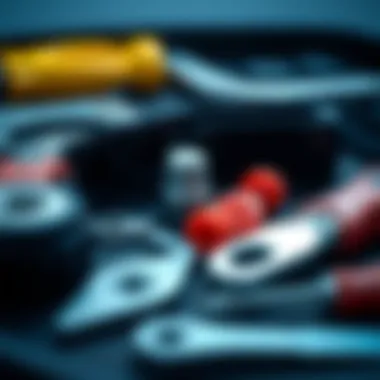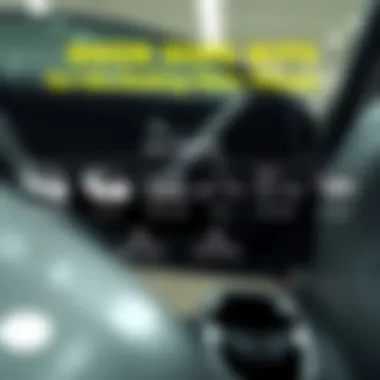Understanding Door Ding Kits for Vehicle Maintenance


Intro
In today's fast-paced world, maintaining a vehicle's appearance goes beyond just regular washing and waxing. Ensuring that your car remains in top-notch condition is a key concern for many enthusiasts. One common problem many face is dealing with those pesky door dings—small indentations that can mar the sleek lines of an otherwise pristine automobile. Fortunately, door ding kits have emerged as a practical solution for timely repairs.
These kits offer an avenue for vehicle owners to tackle minor imperfections without the need for expensive body shop visits. Understanding the mechanics behind these tools not only helps in enhancing your repair skills but also aids in preserving the value of your investment. In this piece, we'll delve into the various aspects of door ding kits—from the types available and their components to practical usage techniques. By the end, you’ll have a thorough understanding of how to effectively use these kits and the technology behind them, ensuring you can make informed choices for your vehicle maintenance needs.
Market Research Overview
Industry Trends and Insights
As the automotive industry evolves, so too do the methods of maintaining and repairing vehicles. The increasing number of urban dwellers, along with a growing awareness about vehicle aesthetics, has led to a surge in the demand for door ding repair kits. More and more drivers are becoming interested in do-it-yourself repairs, driven by the rising costs associated with traditional repair services. Recent market research reveals a notable increase in online sales of these kits, indicating a shift towards convenience and self-sufficiency.
In particular, trends indicate that eco-conscious consumers are also favoring products that align with their values. Many modern door ding kits use materials that are less harmful to the environment, contributing to their growing appeal. As such, this segment of the market demonstrates a unique interplay between consumer behavior and product development, making it a hotbed for continuous innovation.
Consumer Demographics
Understanding who is purchasing door ding kits can help in identifying the target market more accurately. The typical buyer ranges widely in age and background but tends to share a few notable characteristics:
- Automotive Enthusiasts: This segment is typically well-informed and passionate about vehicle care and maintenance. They are often the first to adopt new methods and products.
- Budget-Conscious Consumers: Many car owners are looking for cost-effective solutions to avoid hefty repair bills from body shops.
- Eco-Friendly Consumers: A small yet growing cohort is actively seeking products that feature environmentally friendly components.
This diverse audience creates opportunities for companies to market tailored solutions that resonate with each group’s unique needs. Understanding these dynamics can help businesses innovate and improve their offerings, ensuring they cater effectively to their customers.
"The evolution of DIY automotive repair has democratized vehicle maintenance, putting the power back into the hands of the everyday consumer."
Reviews and Ratings
Detailed Product Breakdown
When exploring the market, it becomes essential to compare several door ding kits to identify the best options available. A typical kit often includes:
- Pulling Tool: Used to gently pull the dent out; often comes with different attachments.
- Hot Glue: Used for adhering the pulling tool to the dent effectively.
- Tapping Tool: Helps to fine-tune the surface after pulling.
- Instruction Manual: Guides users through the process step-by-step.
Not all kits are created equal, so reviewing the composition and quality of each component becomes crucial in the selection process.
Expert Review Summaries
Several expert reviews highlight the significance of understanding features such as ease of use, effectiveness, and price points. Many automotive reviewers recommend looking for kits that are versatile and user-friendly, especially for those who may not have prior experience in repairs. Kits that incorporate instructional videos or access to online guides often receive higher praise, as they enhance the learning experience and increase user confidence.
Prelude to Door Ding Kits and Their Importance
Maintaining the appearance of your vehicle isn't just about keeping it shiny; it's about preserving its value. Door ding kits serve as key players in this realm of automotive upkeep, offering an efficient solution for tackling the unsightly dents that often mar the otherwise pristine panels of a car. A door ding, that all-too-common indentation from a careless swing of a neighbor’s car door or a rogue shopping cart, can inflict significant emotional distress on car owners, particularly those who take pride in their vehicle’s aesthetics. Consequently, understanding the importance of door ding kits is essential for anyone invested in vehicle maintenance.
A door ding kit provides tools tailored for easy repairs without the expense and downtime associated with traditional body shop methods. Their significance cannot be overstated: they offer cost-effective solutions and empower owners to take control of their vehicle’s cosmetic health. Imagine walking up to your car after a long day, spotting a fresh ding, and knowing you can address it right then and there—without the hassle of scheduling a repair appointment.
Moreover, keeping your vehicle looking sharp has real-world implications beyond aesthetics. An appealing exterior can affect resale value, as potential buyers often notice cosmetic imperfections. Recent studies suggest that maintaining a vehicle’s aesthetic appeal can increase its resale value by as much as 10% or more. Therefore, door ding kits not only take care of your visual pride but can also serve as sound investments.
In summary, door ding kits are essential for anyone wanting to maintain their vehicle's aesthetics and value. With the right tools at hand, owners can address minor imperfections before they escalate, fostering a sense of pride and ownership. Ultimately, understanding these kits provides you with the knowledge and power to keep your vehicle looking its best.
Definition of Door Dings
Door dings refer to small dents or imperfections that occur on a vehicle's body, predominantly caused by contact from other vehicles or objects, like shopping carts. These dings usually happen in crowded parking lots, where the proximity of cars increases the likelihood of accidental contact. While they may seem minor, door dings can be an eyesore, especially on a new or well-maintained vehicle. These dents typically don't damage the paint or structural integrity, making them a repairable nuisance rather than a major disaster.
The Importance of Maintaining Vehicle Aesthetics
The external appearance of a vehicle reflects more than just its brand or model; it conveys pride of ownership and attention to detail. A consistently well-kept vehicle not only stands out on the road but also expresses values of care and responsibility. Over time, neglecting aesthetic qualities leads to a deteriorating condition that can diminish performance, even if it isn’t related to mechanics.
Moreover, repairs can also serve as deterrents against rust and corrosion. When door dings and scratches are left untreated, they expose metal surfaces to the elements, which can lead to rust formation. Addressing such issues promptly using door ding kits is an effective means to maintain both aesthetics and functionality, prolonging a vehicle's lifespan. Not only does keeping your vehicle in top shape enhance its marketability, but it also fosters a loyal relationship between owner and car.
"An investment in aesthetics is an investment in value."
Types of Door Ding Kits Available
When it comes to vehicle maintenance, door ding kits are an essential tool for both professionals and DIY enthusiasts alike. Understanding the different types available can greatly influence your choice, helping you find a kit that suits your specific needs and preferences. This section aims to outline the various types of door ding kits, addressing the unique advantages and considerations that come with each one.
Professional Door Ding Kits
Professional door ding kits are designed for those who prioritize quality and effectiveness over cost. Typically used by body shops or automotive repair technicians, these kits come equipped with high-end tools and materials that ensure the best possible results.
Advantages of professional kits include:
- Durability: Made from robust materials, these kits often withstand the rigors of daily use.
- Comprehensive Tool Set: They usually offer a wide range of tools, which could include advanced pulling systems, heat guns, and multiple sizes of pulling tabs.
- Expert Guidance: Often, professional kits come with detailed instruction manuals or access to training resources, ensuring users can achieve optimal results.
While the price tag may be steep, the payoff often justifies the investment, particularly for those who deal with multiple vehicle repairs.


DIY Door Ding Repair Kits
On the other hand, DIY door ding repair kits cater to the average car owner who prefers to take on minor repairs themselves without breaking the bank. These kits are more accessible and offer a simpler solution for small dents and dings.
Key features include:
- Affordability: Priced much lower than professional kits, DIY versions make the door ding repair process accessible to a broader audience.
- Ease of Use: These kits usually focus on basic tools like glue guns and pulling tabs that anyone can pick up with minimal experience.
- Portability: Typically lighter and more compact, making them easier to store in the trunk.
However, a DIY kit might not always deliver the same level of results as a professional one, particularly with deeper dings or complex imperfections.
Comparison of Features and Cost
When trying to make a choice between professional and DIY kits, it’s worth taking a closer look at the features and cost. Cost is a significant factor; professional kits can range anywhere from $300 to $1,000, while DIY kits often sit between $30 to $150.
Some aspects to consider for comparison:
- Tool Variety: Professional kits usually contain a wider array of specialized tools compared to basic DIY kits, which might only focus on the essentials.
- Repair Capability: A professional kit can tackle significant dings that a DIY kit might not effectively resolve.
- User-Friendliness: Many DIY kits are designed so that even a novice can successfully perform repairs, whereas professional kits may require a certain degree of skill.
Understanding these differences can help you make a savvy choice tailored to your expertise level, budget, and the severity of the dent on your vehicle.
Components of a Door Ding Kit
When it comes to door ding repair, the tools and accessories you have in your kit can make or break your efforts. A door ding kit comprises several components designed to simplify the repair process, ensuring that vehicle owners can address unsightly dents without resorting to costly bodywork. Understanding each component's role is crucial in not just the effectiveness of your repair but also in maintaining the overall value and appearance of your car.
Essential Tools in the Kit
Glue Gun and Glue Sticks
A glue gun is essential in most door ding kits, serving as the first point of attack against those pesky dents. The hot glue sticks, when melted, form a strong bond with the pulling tabs. This is vital because, without a secure connection, your repair efforts will be futile. One standout feature of the glue gun is its ability to heat up quickly, allowing you to work efficiently. However, precision is key, as applying too much glue can lead to an overly messy situation. The favorability of glue guns comes from their availability and ease of use even for novices. Still, if you're not careful, it can become a slippery slope to a glue catastrophe.
Pulling Tabs
Pulling tabs are another cornerstone of door ding repair kits. These small, often metallic, tabs attach to the glue that you’ve applied to the dent. Their key characteristic is the design, which allows for a firm, yet flexible grip during the pulling process. Using these tabs correctly can transform a crumpled fender back to its former glory. A unique feature of pulling tabs is that they come in various shapes and sizes to accommodate different types of dents. Yet, selecting the wrong tab might just lead to more frustration than repair, so selection is quite important.
Slide Hammer
The slide hammer is a powerful tool that often carries a reputation for doing the heavy lifting in a repair job. Designed to deliver a swift pulling motion, it can effectively remove stubborn dents with minimal effort. The ergonomic design works wonders for leverage, making it an essential tool in any door ding repair kit. One of its advantages is the versatility it offers—helping in various locations around the vehicle. However, keep in mind that improper use can lead to surface damage.
Tap Down Tools
No repair kit is complete without tap down tools, which are designed to assist in finining touches after the main dent has been pulled. They help in pushing down any high spots and refining the surface to achieve a smooth finish. What makes these tools unique is the ability to precisely control the force applied, preventing further damage during the finishing phase. Having a variety of tap down tools in your kit can enhance the flexibility of your repair project, but one should be careful, as applying too much force can be counterproductive.
Supplementary Accessories
Alongside essential tools, supplementary accessories play a crucial role in ensuring a successful repair process.
Cleaning Agents
Cleaning agents are fundamental for surface preparation before any dent repair work begins. These products help remove dirt, grime, and wax that could hinder the adhesive of the pulling tabs. A standout characteristic of effective cleaning agents is their ability to be safe on automotive paint while also providing enough strength to tackle stubborn residues. A unique feature is the quick-evaporation formula that leaves zero residue. However, using low-quality cleaners may lead to surface imperfections, so always read the labels.
Instruction Manual
Having an instruction manual is like holding a roadmap in unfamiliar territory. It provides insights into the best practices and step-by-step guidance on how to properly execute repairs. Good manuals often cater to a range of skill levels, making them accessible to both experienced professionals and DIY enthusiasts. The key advantage lies in troubleshooting tips that might save you from costly mistakes. However, if the manual lacks clarity or detail, it can leave many puzzled at critical steps of the repair process.
Protective Gear
Finally, protective gear should not be overlooked when embarking on a door ding repair journey. This gear includes gloves and possibly goggles, all designed to keep you safe during the task. A notable characteristic of protective gear is that it allows you to work with confidence, knowing you’re protected from glue spills or accidental tool slips. Unique features often include materials that offer durability and comfort. On the downside, some people may find them a bit uncomfortable, but when it comes to safety, it's a small price to pay, wouldn’t you say?
"The right tools and accessories can make all the difference when repairing door dings."
Techniques for Effective Door Ding Repair
Repairing door dings is not only about fixing visible blemishes but also about preserving the integrity and value of a vehicle. Understanding effective techniques can make all the difference in achieving a satisfactory result. Proper methods ensure that the repair is seamless and that the vehicle remains in top condition. The significance lies in knowing how to approach these repairs with confidence, minimising damage and maximising quality.
Preparation and Assessment
Before diving into any repairs, it's crucial to assess the situation thoroughly. This stage involves close inspection of the ding to understand its depth, size and location, as well as determining the type of paint finish involved. A clean surface is paramount; therefore, washing the affected area with soap and water to remove dirt and debris is essential. Once that's done, let the area dry fully. Tools like a pull gauge can help determine the dent's depth more accurately, enabling informed decisions on the required repairs.
In addition to examining the physical aspects of the ding, it's wise to consider your own skills and tools available. Familiarizing yourself with the repair kit's components can save time and prevent complications later on. Take stock of what you have on hand before proceeding.
Applying Heat and Glue Techniques
The application of heat to the affected area is a critical step in many DIY door ding repairs. The heat helps loosen the material, making it more malleable and easier to manipulate. When using a heat gun, be cautious not to concentrate heat on one spot for too long, as this can lead to surface damage. A safe distance—around six inches from the surface—is a generally recommended practice.


After heating, the next step typically involves the glue technique. This entails applying a specific adhesive to the pulling tabs provided in the kit and placing them securely on the dent. After allowing the glue to reach its optimal holding state, use a slide hammer to gently pull the tab outwards. This method often yields the best results when done patiently.
Pulling and Finishing Touches
Once the initial pulling is complete, it's time to assess the dent again. Depending on how well the goal was achieved, additional pulls may be necessary. The aim is gradual correction; rushing through the process can result in a new dent or an imperfect finish. Using tap down tools can help in smoothing out any high spots left behind. Gradually tapping down the surface can blend the area better with the surrounding paint, thus enhancing the final appearance.
Finally, as a finishing touch, cleaning the area with a gentle polish ensures that any traces of glue or other residues are removed. Also, a light polishing can restore some of the paint's original sheen.
"Patience and precision, more than strength, are crucial in achieving a successful door ding repair."
These techniques, when executed properly, not only improve the look of the vehicle but also maintain its value. With hands-on practice and close attention to detail, anyone can handle minor dings effectively. For more detailed guide and user experiences, you can check out resources like Wikipedia or discussions on Reddit.
Analyzing the Effectiveness of Door Ding Kits
When it comes to maintaining the pristine appearance of your vehicle, understanding the effectiveness of door ding kits stands as a pivotal element. Door dings, those annoying little dents often caused by careless parking or unexpected accidents, can drastically alter the overall look of a car. Not only can they be a source of embarrassment, but they can also impact the resale value of the vehicle if not properly addressed. This section delves into how door ding kits can effectively resolve these issues, examining their benefits, considerations, and the real-world implications of using such tools.
Success Rate and Repair Quality
The effectiveness of door ding kits can largely be assessed through two lenses: success rate and repair quality. A well-designed kit can deliver impressive results, potentially returning your vehicle to a near-original state. Statistics suggest that many DIY enthusiasts report over 80% success rates in removing minor dings and dents, particularly those that are shallow or not creased. Achieving a professional-like repair often depends on two key factors:
- User Expertise: Understanding the tools and methods provided in the kit is critical. Knowing how to use the glue gun effectively, for instance, can significantly influence the repair's quality.
- Condition of Damage: Shallow dings are typically easier to fix, while deeper dents may require more finesse and experience.
However, the results can vary widely. Not all kits produce the same outcome. High-quality kits often come with professional-grade tools and detailed instructions, while cheaper alternatives may fall short, leading to subpar repairs. Therefore, selecting the right kit for the specific damage is a vital step.
"The right door ding repair kit not only restores the look of your vehicle but also saves a good chunk of change compared to professional repairs."
Impact on Vehicle Resale Value
The potential impact of repairing door dings using these kits can resonate beyond just aesthetics—it can influence the resale value of your vehicle. Cars that are well-maintained tend to fetch higher prices on the market. By addressing dings and dents, you not only improve the cosmetic appeal but also enhance perceived value. A study by the National Automobile Dealers Association indicates that minor damage can lower resale value by as much as 15%, depending on the overall condition of the vehicle.
Considerations for Vehicle Resale:
- Complete Repairs: It's important to repair beyond just the visible damage. Any underlining issues, like scratches or paint chips, should also be addressed to maintain value.
- Documentation: Keeping records of repairs and improvements can reassure potential buyers of your dedication to maintaining the vehicle.
- Time Frames: Addressing these cosmetic issues promptly will often yield the best outcome in terms of resale, as buyers prefer vehicles that appear well-cared for.
Overall, using door ding kits effectively not only refines your car's appearance, but also strategically positions it for a profitable resale, showcasing the dual benefits of immediate satisfaction and future financial advantage.
Common Mistakes to Avoid During Repair
Door ding repairs might feel straightforward, but there are several pitfalls that can turn what should be an easy fix into a headache. Recognizing these common mistakes is crucial for anyone looking to maintain their vehicle's aesthetic without causing further damage.
Over-Reliance on DIY Kits
While DIY kits can be convenient, they often come with a caveat: they’re not one-size-fits-all solutions. Many enthusiasts trust these kits blindly, assuming they can tackle any level of damage. However, the complexity of auto bodywork can vary significantly. A minor dent might yield to a DIY kit, but a more pronounced ding could shrug it off completely, leaving the car owner frustrated.
Engaging with professional help when necessary can save both time and money in the long haul. It’s all about finding that right balance. While there's a sense of empowerment in doing it yourself, knowing when to call in a pro can make a world of difference. And let's face it, the goal is to restore that pristine finish, not just put a Band-Aid on the problem.
Neglecting Surface Preparation
Good surface preparation is the unsung hero of successful door ding repairs. Failing to clean the area properly can lead to less effective adhesion or the presence of residual contaminants, which can mar the final finish. Imagine applying that specialized glue on a dusty surface—it's a recipe for disaster.
What’s more, neglecting to check for paint chips or scratches can ultimately impact the repair quality. Before diving into repair, make sure the area is immaculate. Clean the surface with suitable cleaning agents, and consider using a clay bar to polish it if needed. This step enhances the likelihood of a smooth and successful repair, ensuring the results speak for themselves.
Ignoring Manufacturer Guidelines
Each door ding kit has its own set of instructions carefully laid out by the manufacturer. Ignoring these guidelines can lead to unnecessary complications. For instance, the recommended application temperature for certain adhesives can vary significantly; failure to adhere to that could result in a weak bond.
Moreover, many users overlook the components included in the kit. Each part plays a unique role, and using substitutes or making adjustments without consulting the guidelines can lead to unanticipated outcomes.
To maximize your kit's effectiveness, take the time to read through the instructions thoroughly. You wouldn’t take your vehicle to the mechanic and disregard their advice—apply the same logic here. Following these guidelines not only improves the outcome but also prolongs the lifespan of the repair itself.
In short, a little knowledge can go a long way in ensuring superior results when repairing door dings. By avoiding over-reliance on DIY kits, focusing on proper surface preparation and adhering to manufacturer instructions, you're well on your way to keeping your vehicle looking fabulous. Remember, restoration is an art, not just a science.
Legal and Insurance Considerations
When it comes to managing door dings, understanding the legal and insurance aspects can be just as crucial as knowing how to repair them. Engaging in an effective repair process may involve various legal stipulations and insurance provisions that every car owner should heed.
Understanding Insurance Policies
Navigating the maze of insurance policies can be daunting. Each company has its own guidelines when it comes to covering vehicle damage, which includes door dings. First things first, it’s wise to check if your policy covers minor cosmetic repairs. Many people often gloss over the fine print, assuming all damage is broadly covered. However, some plans may not provide compensation for cosmetic issues unless they are tied to a more significant incident, such as a collision.
- Types of Coverage: Look for collision coverage and comprehensive coverage, as they might cover repair costs in specific situations.
- Deductibles: Be aware of your deductible amounts—these are the costs you have to pay out of pocket before your insurance kicks in.
- Claim Process: Knowing how to file a claim and the documentation required can save you from potential headaches. Always have receipts, photographs, and appraisal reports handy.
In essence, understanding insurance policies is not just about what coverage exists, but also about how efficiently one can navigate them when faced with damage. It’s a good practice to consult your insurance agent regarding what services and repairs are covered.


Liability Concerns Post-Repair
Liability can rear its head post-repair when considering who is responsible if something goes awry after a DIY door ding repair. Car owners should keep certain points top of mind. Did you know that performing repairs yourself can sometimes void certain elements of the warranty if not executed properly? Many warranties require that repairs be done by certified technicians. Here’s how to tackle this:
- Repair Quality: If the quality of your DIY repair is subpar and leads to further damage, you might find yourself liable for additional repair costs. In such cases, contractors may actually hold you responsible for damages incurred by improper procedures.
- Documentation: Collect all paperwork associated with the repair, including warranties and receipts. If any post-repair issues arise, being able to reference these would implicate who bears the responsibility.
- Third-Party Repairs: If you opted for a professional service, it’s essential to clarify liability terms. Many service providers will have insurance for their work. Always confirm the scope of these guarantees as well.
"An ounce of prevention is worth a pound of cure," they say. Knowing your liabilities isn't a matter of paranoia, but rather a self-protective measure.
By comprehending both the insurance policies and liability considerations, vehicle owners can achieve peace of mind, ensuring they’ve covered all bases when it comes to door ding repairs. Understanding these elements not only mitigates risks but also enhances your confidence in addressing and managing such vehicle maintenance issues.
Customer Satisfaction and Feedback
Customer satisfaction is an often overlooked but crucial element when discussing door ding kits. It's not just about fixing a dent; it’s about ensuring that customers feel their investment in a kit or service was worthwhile. A well-documented user experience can reveal insights into how effective these kits truly are, which can shape future offerings in the market.
The benefits of understanding customer satisfaction go far beyond the initial sale. For one, satisfied customers are more likely to recommend products or services to others, creating organic word-of-mouth advertising. They may share their experiences on platforms like Reddit or Facebook, influencing potential buyers. This type of feedback is invaluable for both manufacturers and other consumers navigating the complex landscape of door ding repairs.
Moreover, analyzing feedback allows companies to pinpoint what features or aspects customers value most. Are they more concerned with the ease of use? The effectiveness of the kit? Or perhaps the cost-to-benefit ratio? By gathering and interpreting this data, manufacturers can refine their products, making them not just customer-oriented but also trendsetters in their niche.
"Feedback isn't just an option; it's a lifeline for improvement in the automotive repair field."
Evaluating User Experiences
User experiences can shed light on the practicality and expectations surrounding door ding kits. Not every product is a perfect fit for every user; some folks take to DIY repairs like a duck to water, while others feel more at home in a garage with seasoned mechanics. Customer reviews that detail personal triumphs and downfalls offer a nuanced understanding of how door ding kits perform in real-world scenarios.
Factors like ease of application, kit effectiveness, and the support provided by customer service come into play here. Positive experiences are invaluable for building brand loyalty. Customers are more likely to return to a brand if they felt supported and guided throughout their repair process. A good heuristic to grasp is that when folks see others sharing favorable stories about their experiences, it boosts their confidence in the product.
When evaluating user experiences, it’s also key to note the demographics of the reviewers. Different age groups or skill levels may influence how they perceive and utilize a door ding kit. A review from a seasoned automotive hobbyist may highlight technical aspects, while a new user might emphasize simplicity and clarity in the instructions provided.
Industry Expert Opinions
Industry experts are pivotal in lending credibility to the discussions around door ding kits. Their insights can transform abstract notions into grounded truths. Experts often weigh in on not only the functionality of the kits but also on how they align with evolving technology and consumer needs.
For instance, specialists from well-regarded automotive repair forums or those linked with respected trade journals often provide analyses that transcend subjective opinions. They delve into details like the longevity of repairs made with different kits and the effectiveness of the materials used. It’s one thing to hear a consumer’s praise; it’s another to hear it echoed by a professional who understands the science behind dent repair.
These opinions can also offer guidance on future trends. With innovations on the horizon, industry experts can predict which materials or techniques will soon dominate the market. This forward-looking perspective is essential for anyone serious about vehicle maintenance or looking to keep ahead of the curve.
Explore more about these kits and what users are saying through informative automotive community discussions on sites like Reddit or read expert analyses at Britannica.
Future of Door Ding Repair Technology
The realm of door ding repair is evolving, much like other segments of automotive care. In this age where innovation happens at breakneck speed, understanding the future of door ding repair technology is crucial for enthusiasts, professionals, and everyday car owners alike. As vehicles become more sophisticated and integrated with advanced materials, the methods for addressing minor damages like door dings must adapt as well.
Evolution of Repair Techniques
The traditional methods of repairing door dings involved some combination of tools that applied force to the affected area, often leading to suboptimal results or secondary damage. However, as technology advances, so do the techniques available for repair. Modern repair techniques can involve the use of sensors and enhanced heating mechanisms.
- Precision Tools: Enhanced tools, such as electronic pressure gauges, ensure that the repair work is consistent. Miscalculations in pressure can cause further damage, hence, the demand for precision is paramount.
- Heat Application: Newer techniques utilize heat more effectively. When the metal of the car is warmed, it is often more malleable, making it simpler to restore to its original shape. This reduces the risk of cracks and other undesired outcomes.
- Laser Technology: Laser-assisted repair tools are inching their way into the mainstream. These lasers can evaluate the depth of dings and precisely target the area that needs attention.
Integrating these techniques ensures that repairs not only restore aesthetic appeal but also retain the structural integrity of the vehicle.
Impact of Innovative Materials
The ongoing development of innovative materials in vehicle manufacturing significantly impacts door ding repair technology. The trend toward using lightweight alloys and composite materials has reshaped the vehicle design, but it also poses new challenges for repair.
- Flexible Materials: Developments in flexible materials mean that some dings can simply push back into shape without the need for removal or extensive repair. This flexibility may greatly reduce the time spent on repairs.
- Self-Healing Coatings: Incorporating self-healing materials into vehicle surfaces can drastically affect how we think about repairs. Systems that can mend themselves upon impact may significantly reduce the number of door dings that require technician intervention.
- Recyclable Parts: Innovations aren’t limited to performance-enhancing materials; environmentally friendly and recyclable components are also on the rise. This not only benefits the environment but also leads to a more sustainable approach in vehicle maintenance strategies.
"As vehicles integrate advanced materials and technologies, the future of door ding repair is becoming increasingly sophisticated and environmentally conscious," states industry expert Dr. Ian Carter.
In concluding this exploration of future door ding repair technology, it’s evident that the shifts not only enhance capabilities but also cater to a broader audience. For both car lovers and the everyday driver, keeping abreast of these changes will ensure well-maintained vehicles and informed choices when it comes to repairs.
For more information on automotive innovations, you may check out reliable sources like Britannica or automotive forums on Reddit.
Navigating through the facets of door ding repair today ensures that enthusiasts are well-prepared for the advancements that tomorrow brings.
Closure and Recommendations
As we come to the end of our exploration into door ding kits, it’s evident that these tools play a crucial role in maintaining the aesthetic value of vehicles. Repairing door dings not only enhances a vehicle’s appearance but also contributes significantly to its resale value. Investing in a reliable door ding kit can save car owners a substantial amount on professional repairs and acting as a bridge for owners to maintain their vehicle's integrity without breaking the bank.
Summarizing Key Takeaways
- Importance of Door Ding Kits: They provide a cost-effective solution for maintaining the look of your car, offering users the autonomy to fix minor dents and dings on their own.
- Types Available: There’s a notable difference between professional and DIY kits. While professional kits often come with a higher price tag, they may include advanced tools and materials, making them suitable for frequent use by professionals.
- Essential Components: A standard door ding kit includes tools like glue guns, pulling tabs, and slide hammers, while supplementary accessories such as cleaning agents and protective gear enhance the repair process.
- Techniques for Success: Effective repair techniques are essential. Proper preparation and adherence to manufacturer guidelines significantly influence the outcome of the repair process.
- Future Insights: The evolving technology in repair materials suggests a promising future for door ding kits, potentially offering enhanced tools that simplify and improve the quality of repairs.
Final Thoughts on Door Ding Kits
In wrapping up, it’s important for consumers—especially automotive enthusiasts—to recognize the value that door ding kits bring to vehicle maintenance. They don't just serve as a means to fix a dent but also foster a sense of pride in ownership. A well-maintained vehicle tells a story about its owner's care and respect towards their investment. With options tailored for both pros and novices, there's a path for everyone to ensure their vehicle remains in top-notch condition.
Resources for Further Reading:
- For a basic understanding of the types of dents that can occur, check out Wikipedia.
- To explore user feedback and recommendations, visit forums such as Reddit.
- Looking for in-depth mechanics and repair guidelines? The resources available at some educational sites like University Sustainability can provide valuable insights.







